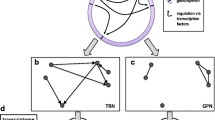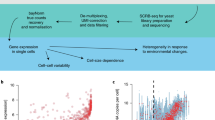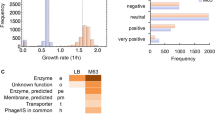Abstract
Transcriptional regulation in differentiating microorganisms is highly dynamic involving multiple and interwinding circuits consisted of many regulatory genes. Elucidation of these networks may provide the key to harness the full capacity of many organisms that produce natural products. A powerful tool evolved in the past decade is global transcriptional study of mutants in which one or more key regulatory genes of interest have been deleted. To study regulatory mutants of Streptomyces coelicolor, we developed a framework of systematic analysis of gene expression dynamics. Instead of pair-wise comparison of samples in different combinations, genomic DNA was used as a common reference for all samples in microarray assays, thus, enabling direct comparison of gene transcription dynamics across different isogenic mutants. As growth and various differentiation events may unfold at different rates in different mutants, the global transcription profiles of each mutant were first aligned computationally to those of the wild type, with respect to the corresponding growth and differentiation stages, prior to identification of kinetically differentially expressed genes. The genome scale transcriptome data from wild type and a ΔabsA1 mutant of Streptomyces coelicolor were analyzed within this framework, and the regulatory elements affected by the gene knockout were identified. This methodology should find general applications in the analysis of other mutants in our repertoire and in other biological systems.










Similar content being viewed by others
References
Aach J, Church GM (2001) Aligning gene expression time series with time warping algorithms. Bioinformatics 17:495–508
Baltz RH (1998) Genetic manipulation of antibiotic-producing Streptomyces. Trends Microbiol 6:76–83
Bar-Joseph Z (2004) Analyzing time series gene expression data. Bioinformatics 20:2493–503
Bentley SD, Chater KF, Cerdeno-Tarraga AM, Challis GL, Thomson NR et al (2002) Complete genome sequence of the model actinomycete Streptomyces coelicolor A3(2). Nature 417:141–147
Bibb M (1996) 1995 Colworth prize lecture. The regulation of antibiotic production in Streptomyces coelicolor A3(2). Microbiology 142 (Pt 6): 1335–1344
Bolstad BM, Irizarry RA, Astrand M, Speed TP (2003) A comparison of normalization methods for high density oligonucleotide array data based on variance and bias. Bioinformatics 19:185–193
Brana AF, Wolfe S, Demain AL (1986) Relationship between nitrogen assimilation and cephalosporin synthesis in Streptomyces clavuligerus. Arch Microbiol 146:46–51
Bystrykh LV, Fernandez-Moreno MA, Herrema JK, Malpartida F, Hopwood DA, Dijkhuizen L (1996) Production of actinorhodin-related “blue pigments” by Streptomyces coelicolor A3(2). J Bacteriol 178:2238–2244
Chater KF, Bibb MJ (1997) Regulation of bacterial antibiotic production. In: Rehm H-J, Reed G (eds) Products of Secondary Metabolism (Biotechnology, vol 7), Weinheim: VCH, pp 57–105
Filkov V, Skiena S, Zhi J (2002) Analysis techniques for microarray time-series data. J Comput Biol 9:317–330
Gadgil M, Lian W, Gadgil C, Kapur V, Hu WS (2005) An analysis of the use of genomic DNA as a universal reference in two channel DNA microarrays. BMC Genomics 6: 66
Hopwood DA, Chater KF, Bibb MJ (1995) Genetics of antibiotic production in Streptomyces coelicolor A3(2), a model streptomycete. Biotechnology 28:65–102
Huang J, Lih CJ, Pan KH, Cohen SN (2001) Global analysis of growth phase responsive gene expression and regulation of antibiotic biosynthetic pathways in Streptomyces coelicolor using DNA microarrays. Genes Dev 15:3183–3192
Kerr MK, Churchill GA (2001) Experimental design for gene expression microarrays. Biostatistics 2:183–201
Kieser T, Bibb MJ, Buttner MJ, Chater KF, Hopwood DA (2000) Practical Streptomyces Genetics. The John Innes Foundation, Norwich:ISBN 0-7084-0623-8
Mehra S, Hu WS, Karypis G (2004) A Boolean algorithm for reconstructing the structure of regulatory networks. Metab Eng 6:326–339
Sankoff D, Kruskal JB (1983) Time warps, string edits, and macromolecules : the theory and practice of sequence comparison Advanced Book Program xii. Addison-Wesley, Reading 382 pp
Schliep A, Schonhuth A, Steinhoff C (2003) Using hidden Markov models to analyze gene expression time course data. Bioinformatics 19 (Suppl 1):i255–i263
Schmitt WA Jr, Raab RM, Stephanopoulos G (2004) Elucidation of gene interaction networks through time-lagged correlation analysis of transcriptional data. Genome Res 14:1654–1663
Talaat AM, Howard ST, Hale Wt, Lyons R, Garner H, Johnston SA (2002) Genomic DNA standards for gene expression profiling in Mycobacterium tuberculosis. Nucleic Acids Res 30:e104
Williams BA, Gwirtz RM, Wold BJ (2004) Genomic DNA as a cohybridization standard for mammalian microarray measurements. Nucleic Acids Res 32:e81
Yang YH, Dudoit S, Luu P, Lin DM, Peng V et al (2002) Normalization for cDNA microarray data: a robust composite method addressing single and multiple slide systematic variation. Nucleic Acids Res 30:e15
Yu J, Smith VA, Wang PP, Hartemink AJ, Jarvis ED (2004) Advances to Bayesian network inference for generating causal networks from observational biological data. Bioinformatics 20:3594–3603
Zou M, Conzen SD (2005) A new dynamic Bayesian network (DBN) approach for identifying gene regulatory networks from time course microarray data. Bioinformatics 21:71–9
Acknowledgements
This work was supported in part by a grant from the National Institutes of Health GM55850. The bioinformatics support was provided by University of Minnesota Supercomputing Institute. SM was supported by a Graduate School Fellowship from the University of Minnesota.
Author information
Authors and Affiliations
Corresponding author
Rights and permissions
About this article
Cite this article
Mehra, S., Lian, W., Jayapal, K.P. et al. A framework to analyze multiple time series data: A case study with Streptomyces coelicolor . J IND MICROBIOL BIOTECHNOL 33, 159–172 (2006). https://doi.org/10.1007/s10295-005-0034-7
Received:
Accepted:
Published:
Issue Date:
DOI: https://doi.org/10.1007/s10295-005-0034-7




